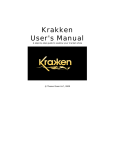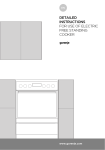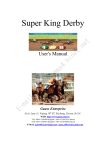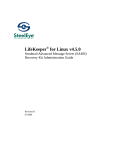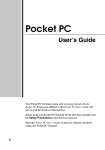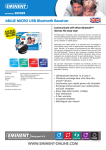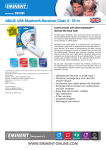Download O - Theme Zoom
Transcript
Krakken User's Manual © Theme Zoom LLC, 2008 © Theme Zoom LLC, 2008 p2 © Theme Zoom LLC, 2008 Table of Contents Overview Swallowing Your Market Whole Educational Keywords Direct Response Keywords Technical Implementation Themes in Krakken VOMA vs. Blueprint Themes How to Comprise a Theme Identifying Potential Themes When to Choose a KGO When to Choose a Theme Defining Synonym Deleting Keywords VOMA Theme Clusters What Are Theme Clusters What Should a Cluster Contain and Why? Fine Tuning Clusters for Analysis Cross Cluster Comparisons Three Phase Approach to Swallowing your Market Whole VOMA Phase 1 VOMA Phase 2 Estimating the Competition About the Ranked Domains Screen Market Strategy Summary Graph Domain Market Share Graph Domain Specific Information with Spark Lines About the Competitive Analysis Screen About the Mini White Paper Refining Final Themes for Blueprint VOMA Phase 3 Importing Keyword Lists Creating Keyword Import List associated with a Cluster Import List Sample Screen Analyzing Converting Keywords in Their Own Cluster What the Heck IS a Silo? Creating a Blue Print Selecting and Adding Silos Selecting and Adding Articles Checking the Results Adjusting Blueprint Articles in VOMA Adding Import Lists to Blueprints Associate an Import List with a Blueprint Adding Keywords for the Import List to the Blueprint Blue Print Outputs Interfacing with Web Development Tools Using TZ for Continuity Sales p3 5 6 8 10 11 14 16 18 19 20 21 22 23 24 26 27 29 32 33 35 37 38 39 41 42 45 47 51 52 53 54 56 59 60 64 67 69 71 72 73 74 79 81 83 84 © Theme Zoom LLC, 2008 p4 © Theme Zoom LLC, 2008 Overview Welcome to the Krakken User's Manual. In this document we cover the following topics: Swallowing your market whole From Keywords to DNA VOMA Themes VOMA Theme Clusters Three phase approach to swallowing your market whole Estimating the competition What the heck is a silo? Creating a blueprint Interfacing with web development tools Using TZ for continuity sales -o- p5 © Theme Zoom LLC, 2008 Swallowing Your Market Whole Here is what swallowing your market whole means to me: You want to be the site - or more likely a series of sites, which so dominates the market place that anybody who is looking for anything about "your product" will not just end up on one of your sites, but will actually spend a good chunk of their "buying cycle" there. What is a Buying Cycle? A potential customer goes through several phases during a buying cycle: o o o o o o initial inquiry product discovery search for social proof brand determination product determination purchase The speed and degree of thoroughness a person will spend on each of the above steps depends largely on the price of the product but also on the individual. Dominate the Market. If you are gong to control and dominate the market, you have to be able to offer the potential client the majority if not all of the responses to the questions he asks in the above buying cycle. The keywords used during the buying cycle break down into two distinct varieties. o Educational o Direct Marketing Let's look at both of these, how they affect your marketing as well as p6 © Theme Zoom LLC, 2008 how they are technically implemented, not just in your website, but in your entire online campaign. -o- p7 © Theme Zoom LLC, 2008 Educational Keywords These are they keywords used during the information gathering process. They target the questions a buyer asks and the answers. White papers, news letters, general info on websites, forums, blogs and more are all common places where information is gathered. When planning out how to swallow your market whole, you'll need to decide which elements of your strategy are targeted for answering buyers questions. You'll need to make sure that you are getting in front of your buyer while they are asking these questions, so you can answer them. That means you'll need to promote your white papers, news letters and the rest using these same keywords. p8 © Theme Zoom LLC, 2008 -o- p9 © Theme Zoom LLC, 2008 Direct Response Keywords Direct response keywords are those used when the shopper is ready to buy. Ideally targeted in Pay Per Click campaigns, they are also be used in sales copy, tele-seminars, webinars and multi-media advertising - as well as major sections of your website. Again, when planning out your strategy, you'll need to identify which elements target direct response and use appropriate keywords. -o- p10 © Theme Zoom LLC, 2008 Technical Implementation The technical implementation is what brings all this together. Typically when I build a site, I start with the direct marketing side because I want to make money now and if someone is looking for me to buy something from me, I want them to be able to find me and then, over time, I go back and pick up the information side of the house, which is often extensive and time consuming to build all the way out. Often, too, these two phases are on different websites, or apparently different rings of sites. The information sites are designed to build trust and offer seemingly unbiased opinions on different products. They can offer newsletters and white papers to build mailing lists and continue to feed information to the potential client even after they have left the site. Of course everything inevitably points to the sales sites where there are 'calls to action' and sales are closed. The Pyramid of Promotion Chart indicates the many levels of advertising, each level taking a different amount of time to be effective. At the top is the quickest, and it gets progressively longer for efforts to turn into effects as you go down. You'll also notice a shift from predominately direct marketing at the top to predominately educational and brand building toward the bottom. p11 © Theme Zoom LLC, 2008 p12 © Theme Zoom LLC, 2008 When you braid the same keyword backbone throughout all the levels of the pyramid of promotion, answering all your potential client's questions throughout their buying cycle, you literally build the DNA of your business success. -o- p13 © Theme Zoom LLC, 2008 Themes in Krakken A 'Theme' is a group of related keywords. The smallest theme possible is a single keyword, known as the 'Parent Theme'. A Theme can be anything from a 'Parent Theme' to a 'Synonymic Set' and array of supporting keywords. A 'Synonymic Set' is comprised of 'Theme Defining' and / or 'Keyword Generation Only' (aka 'KGO') synonyms. Here is how all this works: A theme represents a particular market or market segment. Any market represented by a "Theme" in Krakken and being defined by a set of "keywords" will always, by it's very nature, be incomplete. There will always be a keyword out there "somewhere" that would have a high enough co-occurrence to be relevant to that theme but which the Krakken failed to turn up. Synonyms (KGO and Theme Defining) help to fill in the gaps; i.e. the "missing" keywords for a theme. The same keyword generation algorithms are run for each synonym as those which were run for the parent theme, generating a much longer list of words. The relevance of these additional keywords will be tested against the parent theme, and some of these new keywords will make the cut and be added to the theme because of their relationship to the parent theme. Theme defining synonyms expand the definition of a theme beyond the 'Parent Theme'. A theme which is comprised of a Parent Theme and Theme Defining Synonyms now represents the market which is defined by the union of these themes. The difference between KGO synonym and Theme Defining synonym is that KGO ONLY fills in the gaps, where as a theme defining synonym expands the definition. p14 © Theme Zoom LLC, 2008 -o- p15 © Theme Zoom LLC, 2008 VOMA vs. Blueprint Themes A Theme in Krakken VOMA is a different animal from that within your blue print. A theme in the Blueprint module is designed like a tower. The Parent Theme and Theme Defining Synonyms define the top. Keywords with a high co-occurrence for the synonymic set, and with a scope contained under the parent theme build a strong supporting foundation that clearly defines the market for of that theme. Where as VOMA was designed to help you analyze your market, requiring themes in VOMA to contain more tangent ideas than those within your blue print. Voma offers you a topographical view of your market by showing you not only what is relevant to your current synonymic set, but also the tops of near by peaks in the cost and traffic terrain. p16 © Theme Zoom LLC, 2008 -o- p17 © Theme Zoom LLC, 2008 How to Comprise a Theme Now let's discuss the fine art of when and how to choose Keyword Generating Only Synonyms (KGO) and Theme Defining Synonyms (TD syns) Both of these will affect the generation of your blueprint and it is important that you understand how. Not choosing any synonyms will often result in few or no keywords at the article level in your blueprint. Here we will discuss: Identifying Potential Themes When to Choose a KGO When to Choose a Theme Defining Synonym Deleting Keywords -o- p18 © Theme Zoom LLC, 2008 Identifying Potential Themes In step one of VOMA you should really drill into anything that looks remotely interesting or at all relevant to your theme. Don't stop to think at that point whether or not it belongs in this cluster or that. The reason behind this is that it will turn up some very interesting market segments that you would not have suspected otherwise. -o- p19 © Theme Zoom LLC, 2008 When to Choose a KGO KGO terms in Phase One will skew your results. Don't use them there, keep the themes pure at first. However in Phase Two and Three, choosing a KGO synonym is never a bad thing. These terms are used to generate keywords and increase the chance that your themes will be well covered by a broad selection of keywords. The only down side to selecting a bunch of KGO synonyms is the length of processing time. Therefore, I would use them liberally so long as they are at least tangent to the theme, but I would avoid using them in extreme excess simply to keep the blueprint generation to a reasonable time frame. KGO terms selected in VOMA themes are carried forward into your blueprint and used to generate terms for your blueprint as well. -o- p20 © Theme Zoom LLC, 2008 When to Choose a Theme Defining Synonym Theme Defining Synonyms should be chosen with a bit more care. A theme is defined by ADDING together all the ideas represented by the parent theme and the TD syns. Additionally, each synonym will augment or add a highlight to the theme. Let me give you an example. If your parent theme is "home loans" and you have no synonyms the keywords returned will be rather general terms about home loans. If your parent theme is "home loans" and your one synonym is "bad credit home loans" this will skew your theme strongly toward "bad credit home loans" and you will not have as many general "home loan" terms. If your parent theme is "home loans" and you have 6 synonyms each about different aspects of home loans, your keywords will almost predominately be about those aspects of home loan and not really anything at all about "home loans" in general. The best thing is to play with how the theme results differ with the addition of synonyms in VOMA to get a feel for the best combinations. Often I create and delete the same theme 3 or 4 times with different selections of TD-syns to find the combination that works the best. -o- p21 © Theme Zoom LLC, 2008 Deleting Keywords Deleting keywords in VOMA does not in any way impact your blueprint, but sometimes it is useful in the analysis of a theme. Deleting "interesting" keywords on the short aka "interesting" keyword list will allow other keywords to come forward, if they qualify. All of the graphs and the ranked domains are calculated using the "interesting keyword" list, except the mini white paper, which uses only the synonymic set. When you delete an "interesting" keyword and another keyword moves forward to take it's place, the graphs and ranked domains are updated with the new "interesting keywords". -o- p22 © Theme Zoom LLC, 2008 Theme Clusters The "Theme Cluster" is a new construct available for the first time in Krakken. Originally intended only as an organizational device, its usefulness has far exceeded that. We will look briefly here at what a Theme Cluster can represent, and how it can be used. o o o o What are Theme Clusters? What Should a Cluster Contain and Why? Fine Tuning Clusters for Analysis Cross Cluster Comparisons -o- p23 © Theme Zoom LLC, 2008 What Are Theme Clusters Simply said, Theme Clusters are a collection of Themes. It is in the 'how' that Themes are chosen to be contained within a Cluster which can lead to some interesting analysis. Inherently, a single Cluster can contain only those themes of a specific Locale. I have come to look at a Cluster as representing a market and the themes within them as representing market segments within that market. By carefully crafting a cluster to contain a set of themes that represents a single idea within a market, the cross cluster analysis information can report very interesting data. The idea behind the pie chart is that you can see immediately how much "voice" the top ranking domains have across the entire market represented by this cluster of themes. This is based on TSMV thereby showing who is controlling the money. This is not about who is ranking high for a single keyword, but rather who is ranking most consistently across all the keywords in all the themes. p24 © Theme Zoom LLC, 2008 Above you can see that wikipedia.org holds the majority of the money running through the keywords in this cluster. This is not uncommon when the scope of the theme is large, or the topics are diverse. At that point more general websites, such as wikipedia or about.com, are going to be the domains that rank across all the themes. After wikipedia, the next domains to rank across all the themes, such as mortgage.com, are interesting to note. These domains must either control a handful of some of the most expensive keywords or they have a broad ranking across some rather divergent themes. Either would make them an interesting competitor and someone to be aware of. Below is another cluster where I drilled into all the verticals represented on the original wellness theme. The result was that there is not one domain which dominates all these themes. -o- p25 © Theme Zoom LLC, 2008 What Should a Cluster Contain and Why? A cluster should define a single idea. The scope or domain of that idea will become self evident as you drill into ideas within that market. For example. I found as I was drilling into an aspect of my real estate market, home buying, that different forms of lending were a frequently recurring theme within that market. Eventually I drilled into one of these terms. The keywords that came back were all loan related (no surprise) but they also had very little to do with "home buying". And while there were many "lending" terms in my home buying themes, there were no "home buying" terms in the lending theme. In addition to this, when I looked at the themes overview page, I saw that there was a lot more money in the lending theme (also not a surprise) and it skewed the results in the lending direction, where prior to this all my themes had been competitive with each other. Additionally, suddenly the most dominate domains across the cluster were all lending domains. Clearly this theme did not belong in this cluster. The money weighted it too heavily and it was not particularly relevant to the other themes in this cluster. However, because it DOES have something to do with my market, and because there IS a lot of money there, I am interested in pursuing this topic, but it belongs in it's own cluster with other lending themes. -o- p26 © Theme Zoom LLC, 2008 Fine Tuning Clusters for Analysis On the more granular level, theme cluster analysis can become exceptionally useful when the selection of the themes within the cluster has been done purposefully. Above you can see that the themes have been carefully chosen and only the synonymic set is present - this allows you to see the dominate competition for a would-be blue print is helpguide.org. Contrasting is the image below which shows an equally small set of themes, but after two themes are drilled into, diversifying the keywords. This tends to make generic sites more prevalent such as wikipedia and youtube as show in this pie chart. p27 © Theme Zoom LLC, 2008 Cluster theme analysis will point out who your competition is across the entire market as defined by your cluster. It will also point out where the money is, where the traffic is, and give you rough indicators as to where the shoppers versus information seekers are. -o- p28 © Theme Zoom LLC, 2008 Cross Cluster Comparisons Interesting information can be gleaned by comparing different clusters against each other. Here we compare a cluster of Canadian themes to a cluster of US themes where the themes within the cluster are identical. Naturally the supporting keywords will be different for each locale, reflecting the differences in the local language, so if a cross locale comparison is desired, I would contrast once with just the parent themes, prior to selecting synonyms and prior to the drill for additional keywords, and then again after with full drills. Below is a cluster for a client on Foot Care for the US market: p29 © Theme Zoom LLC, 2008 Here are the same themes, but for the Canadian market: p30 © Theme Zoom LLC, 2008 Comparisons like this speaks volumes for how open foreign markets are. -o- p31 © Theme Zoom LLC, 2008 Three Phase Approach to Swallowing your Market Whole The idea behind VOMA is to discover as many avenues in which questions can be asked during the buying cycle, so you can build out your site(s) to address these issues. These break down into two distinct camps. o Education or Information seeking o Direct Marketing or Purchase seeking Ideally you want to start talking to folks while they are still in the information seeking phase so that you can help lead them toward the decision of buying your product. Sorting VOMA results by numbers of competing pages or traffic especially natural traffic - will give you a feel for the the information seeking terms. Sorting the results by cost will give you an idea of the the purchase seeking terms. It's easiest to put each of the three phases of VOMA research into their own clusters. You might have multiple clusters for each phase of your VOMA research, possibly separating educational keywords from direct market keywords or possible segmenting out different aspects of your market into different clusters. These segments are often defined by cost or topic. Segmentation is also required by geographic locale. Here is a video that focuses on how the locale of a cluster impacts your research and is reflected in your themes. Watch video. -o- p32 © Theme Zoom LLC, 2008 VOMA Phase 1 For my first phase of VOMA I start with money keywords - keywords which have caused a sale, if I have any. Additionally, I look at the competitors top ranked keywords and get ideas there where to start. I also talk to my customer to see what keywords they use to describe their product or service. And if possible I talk to my customer's clients to see what keywords they would use to find my customer. Often each set of starting points is contained within a cluster of their own. From these starting points I drill into a single keyword, deleting all the synonyms and examining every keyword at a granular level. I choose no synonyms because when I drill into the term and I want to see the competition for just that keyword, running the mini white paper if necessary. I make notes at that point of any interesting data. Then I go back to the theme screen and drill into this theme to see what sort of keywords are related to this parent theme and only this parent theme. In this way I get a feel for exactly what this keyword represents within my market. I look down this list and drill into everything that looks remotely connected to my market. I repeat this action for phase 1 until I have drilled into every single interesting term on each of the theme screens and have exhausted the possibilities which are returned by Krakken and those which were given me via money, customer and client keywords. p33 © Theme Zoom LLC, 2008 Here is a video series that shows how to create a theme and analyse the results for a phase one (single keyword) theme. 1) 2) 3) 4) Adding a theme Theme Management Analysis and Ranked Domains screens Competitive Analysis and Mini White Paper Google Trends -o- p34 © Theme Zoom LLC, 2008 VOMA Phase 2 When I have a feel for my market, I move into the second phase. Think of this phase as a sandbox where you try a bunch of different combinations looking for ideas that work well together. Now that I know a little bit about each keyword as it represents a parent theme, I can pull some together and sort them into different piles or clusters. Typically I put information themes in one cluster and sales themes in another cluster. This allows me to see where the money is going easier, so that direct market themes are not overshadowing the information or educational themes. Often I split both education and direct marketing topics out even further into more clusters, keeping each major aspect of a theme together. For a small niche, obviously this is not necessary. When I create these themes I start choosing synonyms from the list presented to me by Krakken and combining parent themes from phase 1 together to see how the union is affected in the keyword generation. Often times I will create the same theme several times, with different combinations of theme defining synonyms and KGOs, watching how the results shift. Note: This is not a particularly linear process. When I'm happy with a particular configuration, I usually bounce directly to Phase 3 and create that theme again in a "final" cluster. Now that we are looking at themes with multiple keywords synonymic sets, let's revisit the competition screens that we looked at briefly in the videos in Phase 1 and see how these screens show an added dimension across a set of keywords. -o- p35 © Theme Zoom LLC, 2008 p36 © Theme Zoom LLC, 2008 Estimating the Competition To be able to effectively launch into a market, you need to know who your main competitors are, how much voice each one of them gets in your target market segments and what they are doing to get that. Without this information you have no idea how much it is going to cost you to break successfully into the front page of the Search Engine Results Page (SERP). With this in mind, we are going to examine three different ways in which Krakken presents this data: o Ranked Domains Screen o Competitive Analysis Screen o Mini White Paper -o- p37 © Theme Zoom LLC, 2008 About the Ranked Domains Screen The Ranked Domain Screen is packed with information about your competitor. And I should mention that you can add your domain or that of a specific competitor, if not listed, to see how you stack up against the top domains ranked for this theme. Let's break this screen down into its three main components: o Market Strategy Summary Graph o Domain Market Share Graph o Domain Specific Information with Spark Lines -o- p38 © Theme Zoom LLC, 2008 Market Strategy Summary Graph Let's look first at the graph on the left below, the Market Strategy Summary: This grid plots how competitive the theme or market segment is over all and at a glance can tell you how many strong competitors you have in this theme. Top to bottom plots coverage; how thoroughly a domain ranks for the important keywords in this theme. Side to side plots promotion; what percentage of the links to a site are deep links, indicating how much juicy material is in that site and possibly the degree to which inbound link campaigns have been effectively thought out. One other feature of this graph is the size of the dot representing the domain. This indicates the yearly ORV based on the terms in this theme for this site. You don't want to be one of the domains in the lower left, ranking p39 © Theme Zoom LLC, 2008 for very few of the terms and without any deep links to your website. The lower right doesn't help much either, having lots of deep links, but still not ranking for many of the important terms. Possibly they rank better for terms in another market segment. If most of the domains are in the upper left, they rank for a significant percentage of the terms in this theme, however have very few deep links, indicating it's probably not difficult to rank in this market segment. Domains represented by a large dot in the upper right are the ones to investigate. Ranking for a high percentage of the important and expensive terms in the domain AND having a lot of deep inbound links, these are the indicators of possibly stiff competition. -o- p40 © Theme Zoom LLC, 2008 Domain Market Share Graph To the right of the Market Strategy Summary is the Domain Market Share Graph. This graph shows how big a slice of the money pie the top competitors in this market segment control. At a glance you can see who the top competitors are and how well the top sites are dominating. The above graph shows that mortgage.com is the only really consistent competitor here with the pie splintering into small segments right after wikipedia. This is either an indicator of a very tough market, where folks have had to pick their battles and are very focused on specific keywords, or a lack of thought about ranking for terms across the entire market segment. This pie is typically in smaller slices at the top of the vertical markets and should be in larger slices in smaller niches. -o- p41 © Theme Zoom LLC, 2008 Domain Specific Information with Spark Lines The bottom part of the Ranked Domain screen gives you a line by line break out of the stats for each domain. Clicking on the domain name itself will take you to the Keyword Analysis screen for that domain where you can see exactly what the ranking for each keyword is for that domain. It also gives you a clear picture of the terms for which they are NOT ranking. This screen can be used as a very effective selling tool. The spark lines are awesome because it gives you a peek into the Keyword Analysis screen while you are still here. It shows you that although mortgage.com has the highest ORV, it's only ranked for one keyword - the most expensive one. Where as wikipedia and bankrate are both ranked for many words in this theme - so, referencing the market strategy summary chart again: p42 © Theme Zoom LLC, 2008 You can see that the two dots which are in the upper right quadrant of the market strategy summary are wikipedia.org and bankrate.com, and mortgage.com is actually all the way over at the left, with no deep links. Since Wikipedia has inbound links for everything, you would need to know how many deep links actually go to the pages actually ranked for this theme to know if they are a force to be reckoned with. At the moment it looks like bankrate.com is the only real dominant competitor in this theme. One of my proof readers asked me why would wikipedia be competition anyway, since they don't sell anything? I have two thoughts that answer this question. 1) Imagine what would happen if wikipedia monetized their site! 2) The presence of wikipedia in the results, especially when they are a top contender indicates to me that other businesses are not thinking this broadly about their market or they do not have the funding or expertise to dominate broadly across these terms. In other words, there is a market to be swallowed ;) p43 © Theme Zoom LLC, 2008 If I have more than a handful of keywords represented in the cluster and wikipedia does NOT show up as a top contender, my competition is thinking about what they are doing and this market may well be something more difficult to break into. -o- p44 © Theme Zoom LLC, 2008 About the Competitive Analysis Screen Moving to the next screen, the Competitive Analysis Screen, you will see that you can see each keyword in the theme on a case by case basis. Here I've sorted by Cost per Click so the order here represents the same order as the spark lines on the Ranked Domain screen. Now we know that the keyword mortgage.com was ranked for was refinancing. The information represented for each of the top three sites for each term are the total number of inbound links, and then in superscript, the percentage of these links which are deep. Hovering over any of the numbers for site 1, 2 or 3 will display the domain being represented. The information here represents the top three ranked domains by keyword to give a feel for the competition behind each term. Competition in this context means two things, the sheer number of inbound links a site has managed to get, and then the percentage of them which are deep. A high percentage of deep links indicates that 1) a site has lots of content worth linking to and 2) Linking p45 © Theme Zoom LLC, 2008 campaigns have been used with a strategy to target deep pages indicative of a site which is more theme conscious. This table is useful for finding particular keywords that may be under optimized in a tough market, but also just to get a general feel for the overall market segment represented by your theme. At this point, if you feel that you need more information, you want to dig deeper into the competition behind this theme, hit the Mini-White Paper Generator tab at the top of this screen. -o- p46 © Theme Zoom LLC, 2008 About the Mini White Paper The Mini White Paper shows you a medium depth analysis for a synonymic set. If the synonymic set for your theme consists of simply the parent theme, then the Mini White Paper shows you the information for just that keyword (example above). You'll notice that the domains are shown in order of Google ORVreal. But, what happened to mortgage.com? It's not on this screen because it only ranked for one keyword, and that keyword, while the most expensive in the theme, is not contained in the synonymic set. p47 © Theme Zoom LLC, 2008 Therefore, in order to see more detail about that domain, you should drill into 'refinancing'. Then, a mini white paper generated for that theme would show the details for the mortgage.com domain. All this is great for seeing what's going on for a single keyword, but in my mind, the power of this tool is when you are looking at a synonymic set! Check this out: The idea here is to run a mini white paper on the synonymic set that you plan to have for your silo landing pages. This will show you who p48 © Theme Zoom LLC, 2008 is controlling the money (ranked by Google ORVreal) and what positions they are holding for each term in the synonymic set to control this share of the pie. Often these results are interesting as in this case; it shows moneycentral.msn.com is your only highly ranked competition across the board. Let's take a closer look at these results - you'll see that the #2 site, militaryfinance.umuc.edu is ranked #2 for investment property and not much of anything else. Likewise, buyincomeproperty.com is ranked #3 for investment property - oh and it's ranked for other terms, too, but I'm starting to see a pattern here. It's actually ranked higher for other terms than umuc.edu is so WHY is it #3. It seems the entire list is skewed around the term investment property. Let's go back to the Market Analysis screen to see why... This is sorted by TSMV, and points out that the traffic for investment property so exceeds the other terms that they are simply dwarfed by comparison. Notice that both the natural and paid traffic support this, and indicate that these numbers are not a mistake. This term is definitely the one out of the four to own, despite the higher number of competing pages for property investments. p49 © Theme Zoom LLC, 2008 I'm excited about this report because it points out, from a different perspective, the domains with whom you are really competing for the really important terms. -o- p50 © Theme Zoom LLC, 2008 Refining Final Themes for Blueprint At this point you understand your competition for each of the main keywords in your synonymic sets. Now you can make an informed decision about which keyword in your Synonymic Set should be the Parent Theme and which should be synonyms. The web development tools which interface with Krakken use the parent theme as the primary targets in those places where only a single term can be targeted. Therefore it is best to design your themes so that the most difficult and important terms to rank for are your parent themes. Most important and most difficult are not always the same keyword. I would choose most important over most difficult for a parent theme, because the most important is the one you really want to make sure you rank for. -o- p51 © Theme Zoom LLC, 2008 VOMA Phase 3 This is where I create another cluster(s) and the themes in this cluster I create with the synonymic sets that I want for my blueprint. These are exact duplicates of the themes in Phase 2, except that I might have switched around which term was my parent theme and which were theme defining synonyms so that the most important term for my market is the parent theme. I don't bother to drill into these themes, as I am already aware of the ideas each of these keywords represent and what the group represents as a whole. When I go on to create my blueprint I chose the themes from the cluster(s) in the third phase of my VOMA research. The only themes in these clusters should be the "finalized themes", having used the phase one and phase two clusters for my sandbox ideas. These "finalized themes" often provide very interesting cross cluster information for analysis as we mentioned before. -o- p52 © Theme Zoom LLC, 2008 Importing Keyword Lists Imported keyword lists are associated with a Cluster because they must be associated with a Local - in other words, a language. Later, at the Blueprint stage, you can associate your blueprint with one or more keyword lists you created in VOMA. We'll cover blueprints in a little bit. Right now we are going to talk about: Creating Keyword Import List A Sample of an Import List Analyzing Converting Keywords in their own Cluster -o- p53 © Theme Zoom LLC, 2008 Creating Keyword Import List associated with a Cluster From the Cluster Themes Overview page you can click on "Import Lists" on the sub menu and see all the Imported Keyword Lists associated with this cluster. Here too, you can also create a new import list and submit your keywords. p54 © Theme Zoom LLC, 2008 -o- p55 © Theme Zoom LLC, 2008 Import List Sample Screen I went to WordTracker and stole some keywords related to Payday Loans. I dropped the results into a spreadsheet and then grabbed just the keywords out of the second column. p56 © Theme Zoom LLC, 2008 And imported them into a test list: p57 © Theme Zoom LLC, 2008 You can see the items in dark blue are already themes in this cluster and the items in light purple are already synonyms in a theme in this cluster. From this screen you can drill into any word that looks interesting. I'd be inclined to focus on things with high cost and traffic first. -o- p58 © Theme Zoom LLC, 2008 Analyzing Converting Keywords in Their Own Cluster I would be inclined to create a new cluster when importing the converting keywords for my client so that I can analyze them in a vacuum from the rest of the market. I can then drill into all the keywords which are important themes (high TSMV or competing pages > 7 million) and see the results of these drills amongst themselves. I use this cluster as a Phase One of my research, not choosing any synonyms and seeing how each of these keywords are defined by what is returned in the drill. Chances are high that if the parent theme was a converting term, many of the keywords returned in the drill will convert for him too. Keeping these themes a Phase One allows me to see who the top competitors are for my clients converting terms, and for my client to see where he is missing opportunities for words that are proven to convert for him. Not choosing any synonyms for these terms will make the rank domain and mini white papers highly relevant to important campaigns for him. During Phase 2 I start to combine keywords into a synonymic set and will try combinations of converting terms and unproven terms to get optimal keyword sets. -o- p59 © Theme Zoom LLC, 2008 What the Heck IS a Silo? The idea of a silo is something which is compartmentalized. Thereby "siloing" refers to keeping the things which are in each respective silo separate. Silos in a website have the same idea. In brief, the main themes in your website become the themes for the silos. These keywords are targeted on what is called the "silo landing page". The articles under that silo support the theme of the silo landing page. It is these silo themes into which most of your effort goes to rank, and in so doing, because of the construction of the website, you will end up ranking for all the terms in your articles and supporting keywords as well, relatively effortlessly. There are two kinds of silo websites, 'virtual' and 'directory'. In both virtual and directory structures, the index page links only to the silo landing pages, and not to the article pages underneath them. Virtual Silos p60 © Theme Zoom LLC, 2008 Virtual silos are just that. Virtual. They have no directory structure (such as a CMS), or it is a make over from an old site and the folder structure is chaotic. So a silo structure is superimposed simply by the linking of the silo landing page to the articles, and the articles amongst themselves and back to the silo landing page. It is not as effective as a directory structure, and I suggest against it for terms that are highly competitive. Today most CMS software has a plugin for SEO that will allow you to have paths. I recommend going out of your way to find and install these. Directory Silos Directory silo structures have a folder structure where the name of the folder represents the parent theme of the silo. Under this folder, the silo landing page is the "index" page and all the article pages are named according to their parent theme. In the above representation of a silo structured website, we would have a folder called "real-estate" for the first silo and the first article under that silo would be named "for-sale-by-owner.htm" This gives p61 © Theme Zoom LLC, 2008 us the path of: www.RealEstateUnleashed.com/real-estate/for-sale-by-owner.htm Google gives rather a lot of extra kudos at the moment for having the keyword somewhere in the url string, so this string, rich in keywords, will definitely help in the ranking for these terms. But there is more. By having your main silo theme be the folder name, it explicitly illustrates that all the articles reference the same theme. Bruce Clay maintains that it takes a minimum of 5 articles to establish the theme of a silo. Can you see now how repeating this theme 5 or more times really starts to make a point with Google? Further, the articles in a silo interconnect. Do not hesitate to link to another article within the same silo when ever it applies. Also link out from the article pages to other authority sites. This further tightens and develops the theme of your silo. From the silo landing page you should only link to the article pages. rel="nofollow" If you must link to another silo, link to the silo landing page, or link to the page in question directly but use a no-follow. My policy is to not use no-follows, simply because it is a Google device, and not a standard. Therefore the interpretation that Google (or any search engine) decides to give it could vary over time. No-follows are not considered black hat, but they are trying to manipulate or disguise the very nature of the link, so I always question the necessity for such a link. Now that you have the foundation of silo structured websites, it's time to create a blueprint and get ready to build your website. p62 © Theme Zoom LLC, 2008 -o- p63 © Theme Zoom LLC, 2008 Creating a Blue Print Before we can do anything with a blueprint, we have to actually create a "Blueprint" framework. Here you can name your blueprint (this can be changed later) but you must pick the correct country code and whether you want the blueprint to be a skeleton (outline) or full. The outline blueprint is a style which focuses on a single keyword for each theme. It is elementary by its very nature, making this style of blueprint ideal for smaller businesses and local search. The full blueprint is a power house making use of synonymic sets and supporting keywords. Both styles of blueprints will return 10 suggested articles for each silo, but only the full blueprint will drill out 5 of these articles and automatically select supporting keywords for each page of the website. I should mention that you can add articles to the full blueprint at any point in time, even months after the original blueprint was created, and drill out the new articles for inclusion into the website design. This is just one way you can use Krakken to create a continuity product with your client. p64 © Theme Zoom LLC, 2008 You will only be able to add clusters created with countries for which you have created VOMA clusters. Immediately upon creating the blueprint, you will be prompted to add new silos. -op65 © Theme Zoom LLC, 2008 p66 © Theme Zoom LLC, 2008 Selecting and Adding Silos At this point, selecting your silos is relatively simple. You have the "final" clusters from Phase 3 that contain your ideal configurations, you've tested them with PPC to know which of these are converting and which should be considered information and you've adjusted your butcher paper plan accordingly. You understand the competition and now you are ready to configure your website(s). You can start with just a couple of silos, but then you should have an idea of what your priority is - probably goes hand in hand with your purpose. Go down the list of clusters and find the cluster containing the final theme configurations. Click the [+] in front of the cluster to expand it and see all of the themes. You may choose themes from any or all of the clusters displayed. Choose wisely, as when you hit the submit button at the bottom, your credits are debited from your account. There is no getting these credits back... you will have to enter a help desk ticket and talk VERY sweetly to Ramona ;) p67 © Theme Zoom LLC, 2008 You'll see that both the clusters and themes are hot. Clicking on them will take you to VOMA, to the appropriate screen. Clicking the browser back button will bring you back. Hit the submit button at the bottom to continue to the page where you can select articles. -o- p68 © Theme Zoom LLC, 2008 Selecting and Adding Articles Adding articles is not required. To skip this step, simply hit the submit function without choosing any themes. Krakken will insure any articles you specify are included in your blueprint and then select additional themes for articles so that each silo contains 10 articles. To select article themes that you want to insure are in your blueprint, wait for the screen to refresh and you will see a list of clusters who have at least one theme that meets the requirements for being an article under one of your clusters. Allow me to explain this requirement. In order for an article to properly support a silo, the scope (or number of competing pages) must be smaller than the the scope of the silo. Clicking the plus sign at the left of the cluster will display the themes contained within that cluster. Here you may select as many themes as you desire to specify for your blueprint. You may not specify which silo you want this article to be assigned. Hit the submit function again, and Krakken will examine the relevance and importance of all the articles against all the silos and determine the most appropriate silo for each article. You may examine the automated article choice at this point and make any "adjustments" you desire. Make these changes with care, as Krakken has already picked the best assignments from an algorithmic point of view. Moving an article to a silo which it does not support will cause theme bleeding and require additional inbound links to allow you to rank for your terms and reducing the efficiency of ranking for long tails. Now you can return to the "View all Blue Prints" tab and start the drill of your project. -op69 © Theme Zoom LLC, 2008 p70 © Theme Zoom LLC, 2008 Checking the Results This is as close to tedious as Krakken gets. You need to go through each page for each article and the silo landing page and look at the keywords. You can deselect any keyword which is selected and select any keyword you desire on the list. You can add words to the blueprint using the import function, but you can't necessarily control where they go. If you are not happy with the results of any of the articles, you can pull it back into VOMA, play around with the synonym configuration and then add it back to the blueprint. When you are happy with the keywords on the silo landing page, you need to finalize the silo. Finalizing the silo prohibit your making any further changes to the keywords on the silo landing page, however you will always be able to add articles to that silo. When you are happy with the keywords for any particular article, you need to finalize that article. That will inhibit you from being able to make further changes to those keywords. -o- p71 © Theme Zoom LLC, 2008 Adjusting Blueprint Articles in VOMA Once you have decided on your silos and drilled into them, it is possible that they will bring back articles which have no keywords, despite the fact that they were an ideal theme. One way to remedy this problem is to drill into this theme in VOMA and examine the synonyms that come back. You may find good terms there that were not chosen automatically because Krakken could not determine whether or not the term was actually synonymic with the parent theme. Occasionally even VOMA will not return synonyms which you will find useful. In this case you will have to do some investigating and see if you can find synonyms yourself that are suitable to use. Consider adding several KGO synonyms, too. Once you have made a selection and created the theme with the synonyms you would like to use, return to the blueprint, delete the article which is there and then add the article again from VOMA. Krakken may try to put the article into a different silo and you will need to decide which silo you want it in at that point. You can move it if you so choose. Then drill into the article and hopefully it will return this time with desirable keywords. This operation can be repeated as many times as necessary until you are satisfied with the results. Experience should speed this process up. -o- p72 © Theme Zoom LLC, 2008 Adding Import Lists to Blueprints Adding an import list to a blueprint is a two step process. First you associate the import list with a blueprint. This will allow you to see immediately which keywords in that list are already contained within your blueprint. Second you may choose any additional terms and add them to your blueprint. Adding these terms will cause Krakken to find all the appropriate themes for each of the keywords being added, include them in the keyword list and set the keyword status to active. Let's look at each of these steps in detail. -o- p73 © Theme Zoom LLC, 2008 Associate an Import List with a Blueprint Below you can see I'm in my payday blueprint and I've got an option to 'Manage Import Lists' Krakken does not automatically associate an import list with a blueprint. You must assign it. You can assign as many import lists to a single blueprint as you want. You can assign a single import list to as many blueprints as you want. It can get a little crazy! Here's our thinking as to why we did this. Let's say you have three different import lists of proven converting keywords from three different sources; PPC, web log files and direct response marketing. p74 © Theme Zoom LLC, 2008 You are creating a "swallow your market whole" plan for your client. This means that you are making 10 different blueprints. You will want to be able to access all three import lists from each of these 10 blueprints. So this has to be a many to many relationship. Ok, back to the blueprint at hand! I click on the manage import lists button and I'm taken to this screen: The red arrows highlight the box to check and button to click to connect this import list to this blueprint. Once your list has been tied to a blueprint all the keywords in this list which are currently part of your blueprint will show up with a blue dot beside them. p75 © Theme Zoom LLC, 2008 You are able to hover over those terms and see the part(s) of your blueprint where that term is located. Back at your blueprint, you will find that Krakken has indicated keywords, both selected and non-selected as keywords from your import list. p76 © Theme Zoom LLC, 2008 Notice above that one of the synonyms is listed as imported - the synonym was already part of the synonymic set and Krakken is simply pointing out that it's on your import list. Notice above that not all keywords that were imported are selected or "active"? You can go through your blue print and flip them to an "active" status one by one. Or you can select the keywords on the p77 © Theme Zoom LLC, 2008 import screen and "add" them to the blueprint, causing them all to flip from not active to active automatically. Let's look at exactly how to do that. -o- p78 © Theme Zoom LLC, 2008 Adding Keywords for the Import List to the Blueprint To add keywords from your import list to the blueprint, check the select box of all terms which you wish to add, then click the "begin merge" button at the bottom. You will be able to choose if you want these keyword imported into any or all of the following "states" of articles: o undrilled articles o drilled articles o finished articles This seems a bit complicated, so let me explain what we were thinking. This option is so that if part of your blueprint is already published, you can avoid selecting "finished articles" and it will not try to add these keywords to those areas. Conversely, if you have just finished your blueprint and at that point you finally get a list of converting keywords from your client, you can add them to your finished articles prior to going to the writers. And finally, if you do not intend to ever drill out the "undrilled articles" in your blueprint, why bother wasting the time to have p79 © Theme Zoom LLC, 2008 those checked. Back to adding the keywords. Once started, Krakken will attempt to find all the possible appropriate themes where these keywords qualify as supporting keywords. All silo landing pages and article themes will be examined for all the keywords marked. Any marked keyword which does not fit into the current configuration will be sand boxed, and returning to the import page, you will see these terms so designated. Krakken will attempt to find as many locations for your keywords as possible, and all occurrences of the keywords will be set to "active". -o- p80 © Theme Zoom LLC, 2008 Blue Print Outputs As you finalize items on your blueprint, you will see your blueprint start to grow on the "Site Blueprint" screen. Also under the blueprint tab, you'll see your website starting to take form. p81 © Theme Zoom LLC, 2008 This looks pretty boring until you start clicking on one of the silos then you'll see the articles for that silo appear under the silo menu and the silo landing page keywords on the main part of the screen. Below I'm in the Investment Properties silo looking at the landing page - the articles are listed on the menu under the silo menu. Further clicking into an article will bring you the article keywords for that article. Not only is each page of your website laid out in this fashion, but notice that the parent theme is in an H1 tag and the meta tags for each page have been optimized. If you view the source, you'll be able to see those. -o- p82 © Theme Zoom LLC, 2008 Interfacing with Web Development Tools Using one of the Web Development tools, such as Silo Publisher, that interfaces with Krakken will speed up your blueprint to implementation time greatly. The purpose behind these tools is to automatically generate the meta data and menu structures so that you do not need to think about the tedious parts of the process. This leaves you free to concentrate on the content and filling in the appropriate anchor text links. Silo Publisher has been updated to interface with Krakken, now, as well as retaining its interface with TZ 3. -o- p83 © Theme Zoom LLC, 2008 Using TZ for Continuity Sales Find new and tangent markets by analyzing web log files, search logs and sales logs. Use these new themes to: o o o o Add new Silos Add new Articles Add new themes to Social Media Supporting inbound linking campaign -o- p84 © Theme Zoom LLC, 2008 Index -AAbout the Competitive Analysis Screen 45 About the Mini White Paper 47 About the Ranked Domains Screen 38 -BBlue Print Outputs 81 -CChecking the Results 71 Creating a Blue Print 64 Cross Cluster Comparisons 29 -DDirect Response Keywords 10 Domain Market Share Graph 41 Domain Specific Information with Spark Lines 42 -EEducational Keywords 8 Estimating the Competition 37 -FFine Tuning Clusters for Analysis 27 -MMarket Strategy Summary Graph 39 -OOverview 5 p85 © Theme Zoom LLC, 2008 -SSelecting and Adding Articles 69 Selecting and Adding Silos 67 Swallowing Your Market Whole 6 -TTechnical Implementation 11 Themes in Krakken 14 Three Phase Approach to Swallowing your Market Whole 32 -UUsing TZ for Continuity Sales 84 -VVOMA Phase 1 33 VOMA Phase 2 35 VOMA Phase 3 52 VOMA Theme Clusters 23 VOMA vs. Blueprint Themes 16 -WWhat Are Theme Clusters 24 What Should a Cluster Contain and Why? 26 What the Heck IS a Silo? 60 p86 © Theme Zoom LLC, 2008 w w w .themezoom.com























































































